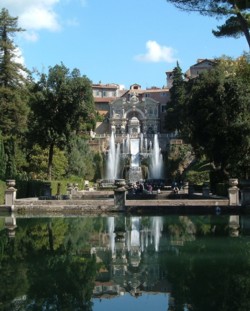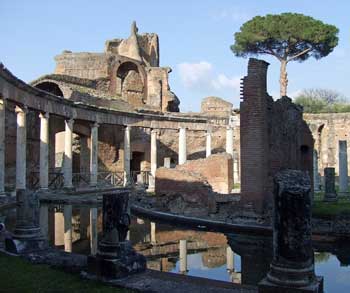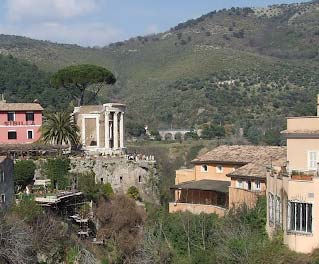Tivoli is a historic hilltown in the Lazio region of Italy, and is one of the most popular destinations for daytrips from Rome. Tivoli’s two most famous tourist attractions are the magnificent gardens of the Villa d’Este and the extensive ruins of Hadrian’s Villa (known as the Villa Adriana).
Tivoli is situated on the Aniene river to the east of Rome, in the Monti Tiburtini hills where the climate is fresher than Rome’s. For this reason, the area was popular from ancient times onwards with Rome’s moneyed classes, who built summer retreats in the area. As the town was on a major trading route from Rome to the Abruzzi, Tivoli has always been an important settlement. Modern Tivoli has around 50,000 inhabitants, and spreads out far beyond the crumblingly picturesque historical centre. In the suburb of Bagni di Tivoli, on the plains below the town centre, it is still possible to bathe in natural thermal springs. The fourth century BC town wall is still visible, as are temples from the second century BC.
There is plenty to occupy the visitor in Tivoli for a day, even if they miss out one of the two famous villas. Travellers keen to see all the sights of the area should note that the Villa Adriana is actually a bus ride outside town; and they may find their day stretched to an uncomfortable length. Some visitors choose to stay in Tivoli, away from the bustle of Rome; if you are very keen on spending a long time at the monuments, or planning to travel onwards through Italy this may be an option worth considering.
Villa d’Este

The Renaissance Villa d’Este was built in the 1550s for Cardinal Ippolito d’Este, the son of Lucretia Borgia. Built over a Benedictine convent, the palace was intended for entertaining and contains lavishly frescoed reception rooms. The main attraction for visitors, however, is the breathtaking garden. Designed to impress the Cardinal’s guests, the Villa d’Este’s gardens are composed almost exclusively of water features. Fountains of every description dazzle the onlooker, from the grand ‘Fountain of the Dragons’ and ‘Hundred Fountains’, to a miniature watery reproduction of Rome. The centrepiece, the gigantic Water Organ Fountain, cascades down a huge drop into quiet, shady pools.
> Read more about the Villa d’Este
Hadrian’s Villa (Villa Adriana)

For those with an interest in antiquities, the Villa Adriana is worth a day to itself. The Emperor Hadrian conceived a countryside dwelling here that would by normal standards be considered a town. A gigantic complex with underground service passages big enough for vehicles (tantalising glimpses are still visible), the Villa incorporates lakes, fountains, libraries, baths, temples and gardens. The area covered is staggering, and highly confusing even when armed with a map; it’s easy to imagine the emperor himself asking for directions.
> Read more about Hadrian’s Villa
Tivoli’s other sights
Villa Gregoriana is an impressive park set in a gorge with a 100m waterfall. The site has recently reopened to the public after restoration by the FAI (Italy’s equivalent of the English National Trust, with free entry to NT members). It’s a pleasant and shady place to ramble. Views over the gorge can be enjoyed from the Ponte Gregoriano.
> Read more about the Villa Gregoriana
Temple of Vesta and Temple of the Sybil – the characteristic round Temple of Vesta occupies a panoramic position above the valley of the Villa Gregoriana, about ten minutes’ walk from the Villa d’Este. A squarish ruin next to the round temple is thought to have been a temple dedicated to the Sybil. Around the temples are dotted the tables of a restaurant; a pleasant place to relax in the middle of antiquity. The area where both these temples is located was the ancient acropolis, and provides excellent views of the cascades and valley below.
Ponte Gregoriano – there was a devastating flood in the 1800s; afterwards the river was diverted and this bridge was built. It was destroyed by retreating German troops in 1944, but rebuilt afterwards. The bridge offers impressive views over the gorge, waterfall and temple immortalised in so many paintings dating from the Grand Tour era.
Picking up a town map at the Tourist Office (a dark green kiosk close to the bus stop in Piazza Garibaldi), a walk through the town takes you past other sights, including the tough-looking Rocca Pia fortess erected by Pope Pius II, the ruined Roman Amphitheatre, the Romanesque Church of St Sylvester and the Cathedral of St Lawrence (San Lorenzo) with its Baroque facade and art including a thirteenth-century wood carving.
Tivoli has several pleasant piazzas and attractive alleyways to admire; in some of which you can see characteristic ‘turret-houses’. Tivoli was obviously an insecure place to live in the Middle Ages, as the residents chose to live in these defensive dwellings with covered roof-terraces and no front door (entrances were on the upper floors and accessible by ladder). Around 100 of these buildings remain; some can be seen in Via del Duomo, Via Platone Tiburtino and Via del Colle.
Tivoli travel and tourist information
Tivoli Tourist Information Office is in Piazza Garibaldi close to the main bus stop and the Villa d’Este. Even if it’s closed, you may be able to pick up maps and information.
Cotral buses run from Rome to Tivoli. Take Metro Linea B to Ponte Mammolo, where you can catch the bus – there are machines, a ticket desk and a newsagent in the station area where you can buy tickets, which you then stamp in the machine provided onboard. The journey is approximately 40 minutes long, though it can take longer as traffic is frequently bad. A few buses each day take the autostrada, resulting in a speedier journey.
Hadrian’s Villa is NOT in Tivoli, but on the plain below the town, a bus ride away. The regular Rome – Tivoli bus stops nearby – ask the driver, and be prepared for a walk. There is also a local bus which takes you there from the centre of Tivoli.
There are plenty of places to eat in Tivoli, including a good cheap tavola calda close to the Villa d’Este, where you can buy slices of takeaway pizza and eat at tables outside. The Villa Adriana is in a less built-up area and options are limited. The villa is, however, full of excellent picnic locations so consider bringing food with you to eat discreetly (I’m not sure if picnicking is officially permitted).
Tivoli festivals and events
10th – 28th February – it’s Carnival time, and floats and masked groups in costume parade through Tivoli’s streets.
5th – 30th April – cultural, artistic and sporting events take place to celebrate the traditional anniversary of the founding of Tivoli. Special guided tours of the monuments are also organised.
May – on the first Sunday in May a holy image of the Madonna is carried through the streets of Tivoli in a procession that ends at the Cathedral.
July – at the beginning of the month a Jazz Festival takes place in the piazzas of the historic town.
10th August – St. Lawrence is the patron saint of Tivoli, and his Saint’s Day is celerated with a mass and a procession, followed by outdoors events and dancing.
10th – 30th September – Tivoli holds a Festival to celebrate the grape harvest, with floats, an art exhibition and tastings.
Tivoli accommodation
Most Tivoli hotels are located outside the historic town, several of them in the Bagni di Tivoli area on the plain, by the thermal spa area. Public transport users could use the buses listed above to travel between their accommodation and the sights, but on the whole staying in the area around Tivoli is best suited to those with cars. There are also, however, some good B&Bs and holiday rentals closer to the sights, both near the Villa Adriana and in the centre of Tivoli. These include the central and rather glamorous Residenze Gregoriane, offering suites in a historic palace, and the more traditional bed and breakfast B&B Catillo.
> Tivoli hotels, B&Bs and holiday homes
Lazio destinations
- About the Lazio region
- Anzio
- Bracciano
- Calcata
- Castel Gandolfo
- Castelli Romani
- Cerveteri
- Formia
- Frascati
- Gaeta
- Palestrina
- Pontine islands
- Ponza
- Rome
- Sperlonga
- Terracina
- Tivoli
- Ventotene
- Viterbo
